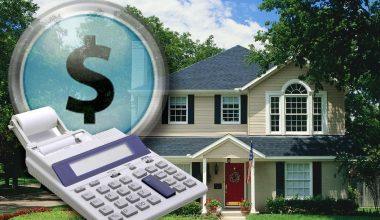When you want to buy a house, knowing your housing expense ratio can help you figure out how much house you can afford. The housing expense ratio is used to figure out how much you may be able to borrow to buy a home. Here’s a closer look at the housing expense ratio, or FHA, and its formula.
Housing Expense Ratio
The housing expense ratio is a ratio that compares housing expenditures to earnings before tax (EBT) or pretax income. Most of the time, lenders use the ratio as part of their credit analysis at the beginning of the lending process. In other words, lenders, such as banks, use the ratio during due diligence while qualifying a borrower for a loan.
The most common application of the housing expense ratio is in home mortgages. To ensure that a borrower can pay back the mortgage loan, lenders examine a borrower’s credit history in great detail.
The ratio is typically used in conjunction with the debt-to-income ratio (DTI) to establish the maximum amount of credit being accessible to the borrower.
A homeowner’s total housing costs include their monthly mortgage payment (principal and interest), as well as their running costs, such as property taxes and insurance, as well as their energy bills, and any other fees associated with their home. It is a truth that lenders want a detailed breakdown of all of a borrower’s housing expenses as part of the loan application.
The total cost of the borrower’s housing has a big impact on the housing expense ratio.
Housing Expense Ratio Fha
During the mortgage application process, FHA housing expense ratio(debt-to-income) criteria are used to compare a borrower’s recurrent liabilities and gross income. To get a better idea of how much money you have to spend each month, you can divide your gross income by your total fixed expenses, which include your mortgage, and divide that figure by your gross income.
There is a 31 percent FHA mortgage payment expense to gross income ratio and a 43 percent FHA total fixed payment ratio for the FHA. The acceptable qualifying ratio for FHA loans is what it is called (4155.1 4.F.1.a).
When applying for an FHA-insured mortgage, lenders must adhere to these standards. Having enough money in the bank to cover your recurring monthly obligations plus the costs of owning a house is essential.
FHA Qualifying Ratio Explained
The FHA allowable qualifying ratio, often known as the debt-to-income ratio, is simply expressed as the percentage of your gross monthly income that goes toward your monthly recurring expenses. There are two primary kinds of FHA’s allowed qualifying ratio:
#1. Mortgage Payment Expense to Effective Income Ratio (4155.1 4.F.2.b ):
To calculate this ratio, all you need to know is how much your monthly mortgage payment costs compared to your gross income. The FHA recommends that your total mortgage payment costs should be no more than 31% of your total effective income. If your house qualifies for the Energy Efficient Homes (EEH) program, the FHA imposes a higher ratio of 33%.
#2. Total Fixed Payment to Effective Income Ratio (4155.1 4.F.2.c):
To calculate this ratio, you must take into account your overall debt commitments, which include your mortgage payment as well as all of your recurrent monthly bills. To qualify for an FHA loan, you must have a fixed monthly payment of 43 percent of your effective income. If you are in the EEH program, the FHA also raises the percentage you need to qualify to 45 percent.
“principal and interest, escrow deposits for real estate taxes, hazard insurance, mortgage insurance premium, homeowners’ association dues, ground rent, special assessments,” and “payments for any eligible secondary financing” are all included in the FHA’s Debt-to-Income Guidelines.
Calculating Your Debt to Income Ratio
You should utilize the front-end and back-end ratios to compute your debt-to-income ratio. Determine your effective income to allowable mortgage payment ratio by using a front-end ratio. You divide your monthly mortgage payment by your gross monthly income.
Using a percentage, multiply the ratio by 100 to arrive at the final percentage. Suppose your monthly mortgage payment is $2,250 and your gross income is $8,500. The following is how you’d calculate your tax:
25% of $2,250/$8,500 is 26.5 percent of the total
To determine your effective income to total fixed payments, apply the back-end ratio calculation. Divide your monthly gross income by the total of your monthly mortgage payment and all other monthly expenses. By increasing the ratio by 100, you can express it as a percentage. Suppose your monthly mortgage payment is $2,500, your total monthly recurring expenses are $1,405 and your gross income is $8,500. Your calculation will look like this:
$2,500 + $1,405, or 43% of $8,500.
Calculate your debt-to-income ratio by using an online tool instead.
Recommended Expense Considerations and Exemptions
Some expenses can be included in a borrower’s total mortgage payment while others can be excluded under the FHA’s debt-to-income criteria. When calculating your debt-to-income ratio, you should take the following debts into account:
- Car payments
- Loan payments
- Credit card payments
- Court-ordered child support
- Alimony
- Legal expenses
You should not include the following items in your debt-to-income calculation:
- Child care expenses
- Utilities
- Rent or current mortgage payment
- Entertainment
However, the FHA changed this clause so that loans that you anticipate paying off in fewer than 10 months are no longer exempt. FHA-sponsored loans are no longer available to you if you have any pending disputes with your creditors over debts of more than $1,000, even if you fulfill the credit score standards.
Other Important Requirements
Additionally, when you apply for an FHA loan, you also have to think about your property taxes and any other factors that might make up for them.
New Construction and Real Estate Taxes
To comply with FHA rules, you must estimate your monthly property tax escrows with exactness. The new development is expected to base property tax estimates on both the land value and any other enhancements to the land, according to FHA rules.
Compensating Factors
If a lender presents significant and well-documented compensatory factors, you cannot exceed the FHA allowable qualifying ratio. HUD-92900-LT Form comments section must provide these compensatory variables from your lender’s perspective. Among the possible compensatory elements are:
- As long as your income and spending did stay the same over the past year or two, you should be able to pay the housing costs you plan to include in your debt-to-income ratio.
- If you’ve got a lot of money or some other means of paying off the house, you might be able to.
- If you spend more than 10% of the recommended down payment on a property.
- If your credit history shows that you can afford to put a larger portion of your income toward housing, you may be eligible for a lower interest rate.
- If you have a good track record of saving and managing your money.
Managing Your Debt to Income Ratio
Do not worry if your ratio of debt to income is higher than what the FHA recommends. You can save money each month by paying down your credit card debts. To reduce your debt-to-income ratio, pay off some of your upcoming recurrent monthly costs now.
Consolidating your debt can also let you stop paying some of your monthly bills. A refinance for debt consolidation makes sense if you own a property and have an excellent credit rating or a large amount of equity in it.
Housing Expense Ratio Formula
Calculating your housing expense ratio doesn’t necessitate complicated calculations or digital calculators of any kind. You can use a few typical metrics you already know about your income and the price of a house you intend to buy to calculate this ratio.
Let’s take a closer look at the housing expense ratio formula.
#1. Add Together All Housing Expenses
Before you start looking for a new home, you need to think about all of the possible costs. The same will be true for those who are evaluating mortgage applications.
Consider a 30-year loan for $250,000 with a 3.2% interest rate. Additional fees include those listed below:
- $208 of mortgage insurance
- $250 of housing association fees
- $250 of property taxes
- $136 of homeowners insurance
- $1080 for your initial principal and interest mortgage payment
To sum it up, you’ll need $1924 in additional costs. When calculating your housing costs, keep in mind that you won’t be paying $250,000 for the house out of the gate.
#2. Calculate Your Total Gross Salary
Now it’s time to figure out how much money you may expect to make each month. For argument, assume your monthly income is $7150. For this statistic, remember to account for any pretax income you receive from your employment or bonuses or child support, or alimony payments.
#3. Divide By Your Pre-Tax Income
Divide your monthly housing expenses by your monthly income to arrive at your housing expense ratio. The following is the formula:
$924 divided by $7150 is equal to 0.269, or approximately 27%.
Using the housing expense ratio method, you should expect to spend around 27% of your pre-tax income on housing costs.
#4. Evaluate the Results
Once you’ve calculated your housing expense ratio, it’s time to review your findings. Keep in mind that underwriters typically reject loans if the housing expense ratio is greater than 28%.
If the underwriter merely looked at the housing expense ratio in our hypothetical scenario, the prospective borrower would most likely be accepted for a loan because the ratio is 27 percent. If your monthly housing costs are greater than 28% of your gross monthly income, you may find yourself in a difficult financial situation.
You still have a chance of securing a mortgage even if your housing expense ratio is higher than 28 percent (though your loan options will necessarily be limited). Some lenders, for example, will accept you if you offer a larger down payment or if you have collateral.
You can always enhance your housing expense ratio over the next few months or even years if necessary, though. You can do this by looking for a more affordable property, finding a house with lower taxes or no additional fees, and so on.
I believe you can determine the housing expense ratio using this step-by-step formula.
What Is Housing Expense Ratio?
Mortgage lenders utilize a housing expense ratio as one of their primary tools for figuring out how much of a borrower’s gross income should go toward paying for a home.
How the Housing Expense Ratio Works
The housing expense ratio is one of the most important pieces of information about a borrower’s income that lenders use to make sure the borrower can pay back the loan.
- To figure out how many houses they can afford, prospective homeowners need to know their housing expense ratio. Most conventional lenders prefer a house expense ratio of no more than 28 percent as a general rule.
- The Federal Housing Administration (FHA) has a slightly higher loan-to-value (LTV) ratio of 31 percent.
- Keep in mind that this amount is considered in context with the borrower’s DTI and other variables, so exceptions may be made to allow for a slightly higher ratio.
How to Calculate a Ratio?
A ratio is a numerical comparison of two quantities by use of division. The formula for such a comparison would be A/B, where A and B are two data points being compared. In other words, you’re taking data point A and dividing it by data.
What is Housing Expense Ratio Formula?
Housing expense ratio formula = Sum of all housing expenses + Your Total Gross Salary, Divide By Your Pre-Tax Income.
What is the housing expense ratio Fha?
FHA housing expense ratio(debt-to-income) criteria are used to compare a borrower’s recurrent liabilities and gross income.
Conclusion
The housing expense ratio is a comparison of housing costs to pre-tax earnings (EBT). Housekeeping costs include anything from basic maintenance to major repairs (utilities, property taxes, insurance, etc.).
The housing expense ratio is simply the sum of all property expenses divided by a pre-tax salary, while FHA housing expense ratio(debt-to-income) criteria are used to compare a borrower’s recurrent liabilities and gross income.
Housing Expense Ratio FAQs
What is housing expense ratio Fha?
FHA housing expense ratio(debt-to-income) criteria are used to compare a borrower’s recurrent liabilities and gross income.
What is Housing Expense Ratio Formula?
Housing expense ratio formula = Sum of all housing expenses + Your Total Gross Salary, Divide By Your Pre-Tax Income.






